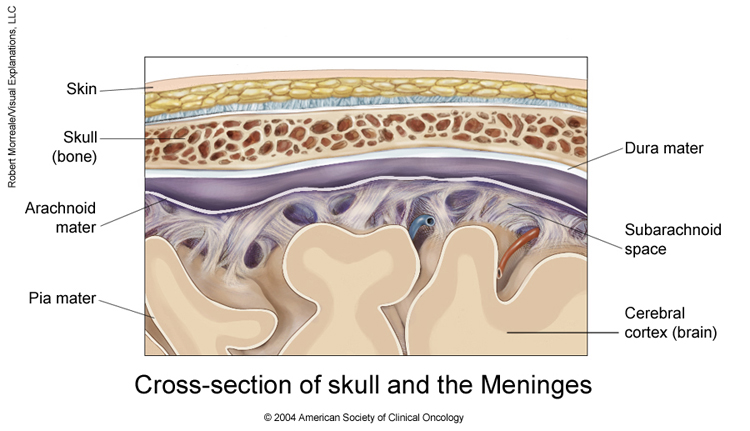ON THIS PAGE: You will find some basic information about this disease and the parts of the body it may affect. This is the first page of Cancer.Net’s Guide to Meningioma. Use the menu to see other pages. Think of that menu as a roadmap for this entire guide.
About the central nervous system
The brain and spinal cord make up the central nervous system (CNS), which controls many of the vital functions of the body. When planning treatment for a tumor in the CNS, doctors consider how a person’s thought processes, movements, and senses may be affected by the tumor and potential treatment options.
About meningioma
A tumor begins when healthy cells change and begin to grow out of control, forming a mass. A tumor can be cancerous or benign. In general, a cancerous tumor is malignant, meaning it can spread or grow into other parts of the body. A benign tumor can grow but will usually not spread throughout the body.
This guide focuses on meningioma. Meningioma is usually a slow-growing, benign tumor that forms on the lining that covers the surface of the brain or spinal cord. It does not grow in the brain but can cause symptoms from pushing inward on normal brain structures. Meningioma starts in the meningeal tissues, which are thin membranes that surround the brain and spinal cord, like a plastic wrap that covers the brain and spine. There are 3 meningeal layers: the dura mater, arachnoid, and pia mater. The meninges protect the brain and spinal cord and help the cerebrospinal fluid (CSF) circulate between the arachnoid and pia layers.
Around 80% of meningiomas are benign. The remaining 20% are either called atypical because they have an increased risk of recurring after treatment or, rarely, are malignant. Malignant meningioma may also be called anaplastic.
Subtypes of meningioma
Meningioma is often classified based on where it starts in the CNS.
-
Falx and parasagittal meningioma. The falx is a membrane that sits in a groove between the left and right sides of the brain. It protects the brain and contains a large blood vessel. Parasagittal meningioma occurs at the top of the falx just on the inside of the skull. These are the most common types of meningioma and make up about 25% of all meningiomas.
-
Convexity meningioma. This type of meningioma occurs on the outer surface of the brain. It makes up about 20% of meningiomas.
-
Sphenoid wing meningioma. The sphenoidal ridge is an area of bone that is located behind the eyes. This type makes up 20% of meningiomas.
-
Olfactory groove meningioma. This type of meningioma occurs near the nerves that connect the brain to the nose. It makes up 10% of meningiomas.
-
Posterior fossa meningioma. Posterior fossa meningioma develops at the back of the brain. It makes up 10% of all meningiomas.
-
Suprasellar meningioma. Suprasellar meningioma occurs next to the sella turcica. This is an area at the center and base of the skull directly behind the nose and between the eyes, where the pituitary gland sits. This type makes up 10% of all meningiomas.
-
Spinal meningioma. Spinal meningioma usually occurs in the spinal column at chest level and may push against the spinal cord. It can cause pain radiating around the chest wall or bladder trouble, weakness, or numbness in the legs. This type makes up less than 10% of all meningiomas.
-
Intraorbital meningioma. This type of meningioma develops in or around the eye sockets. It accounts for less than 10% of meningiomas.
-
Intraventricular meningioma. Intraventricular meningioma occurs in the chambers that carry fluid throughout the brain. This type makes up about 2% of all meningiomas.
Looking for More of an Introduction?
If you would like more of an introduction, explore these related items. Please note that these links will take you to other sections on Cancer.Net:
-
Cancer.Net Blog: Read an ASCO expert’s opinion on what newly diagnosed patients should know about a brain tumor.
-
Find a Cancer Doctor. Search for a specialist in your local area using this free database of doctors from the American Society of Clinical Oncology (ASCO).
-
Cancer Terms. Learn what medical phrases and terms used in tumor care and treatment mean.
The next section in this guide is Statistics. It helps explain the number of people who are diagnosed with meningioma and general survival rates. Use the menu to choose a different section to read in this guide.

